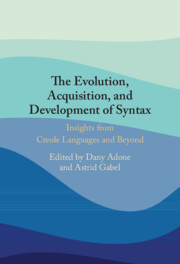Book contents
- The Evolution, Acquisition, and Development of Syntax
- The Evolution, Acquisition, and Development of Syntax
- Copyright page
- Contents
- Figures
- Tables
- Contributors
- Acknowledgments
- Abbreviations
- 1 Introduction
- Part I The Evolution of Syntax
- Part II The Acquisition of Syntax
- Part III The Development of Syntax
- Index
- References
Part II - The Acquisition of Syntax
Published online by Cambridge University Press: 19 February 2025
- The Evolution, Acquisition, and Development of Syntax
- The Evolution, Acquisition, and Development of Syntax
- Copyright page
- Contents
- Figures
- Tables
- Contributors
- Acknowledgments
- Abbreviations
- 1 Introduction
- Part I The Evolution of Syntax
- Part II The Acquisition of Syntax
- Part III The Development of Syntax
- Index
- References
- Type
- Chapter
- Information
- The Evolution, Acquisition and Development of SyntaxInsights from Creole Languages and Beyond, pp. 117 - 190Publisher: Cambridge University PressPrint publication year: 2025

